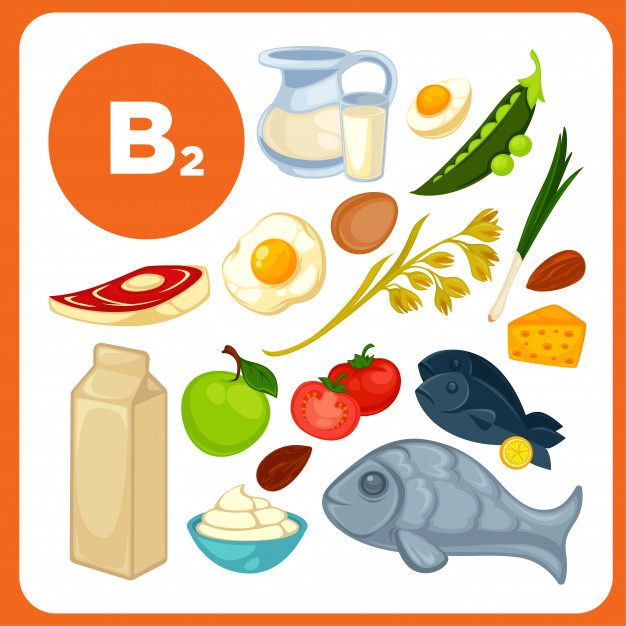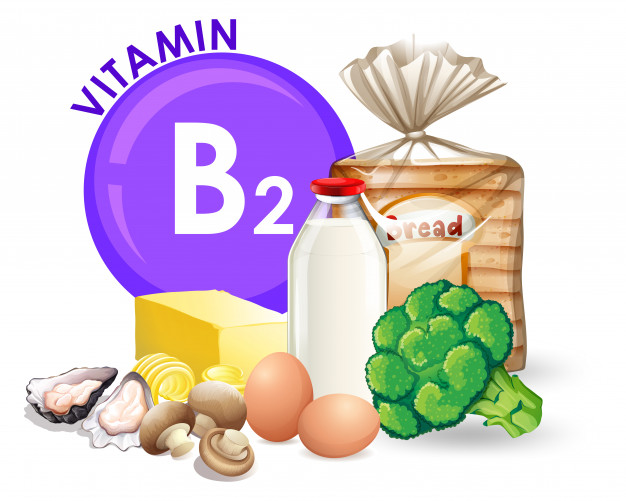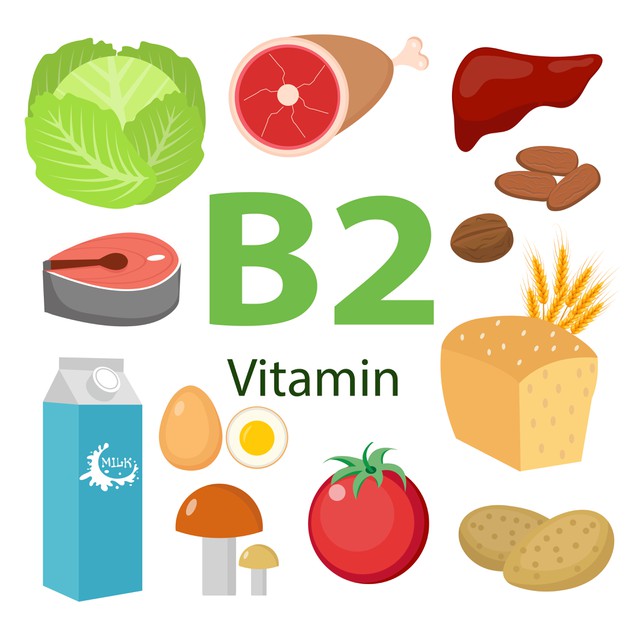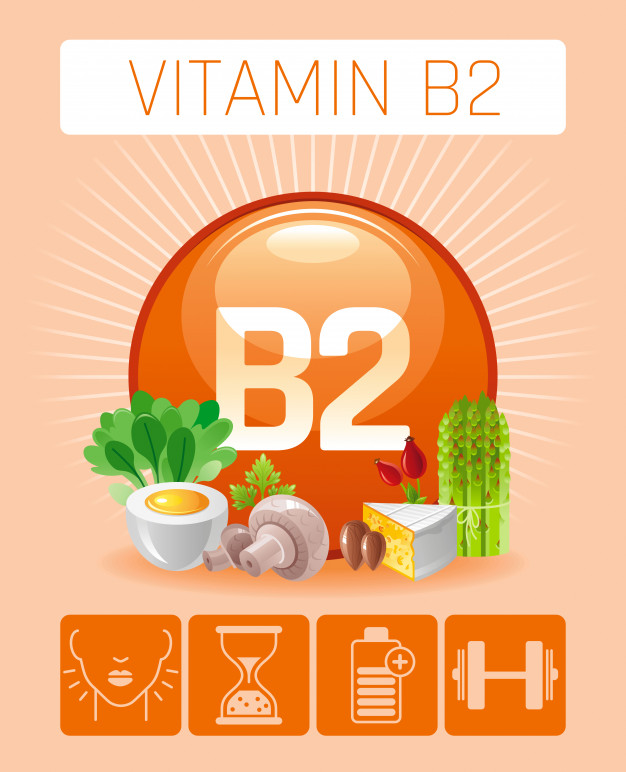Riboflavin is a water soluble vitamin belongs to B complex family. It is also known as Vitamin B2. It plays vital role in performing various important functions of body. It especially helps in cellular respiration (ATP production) by participating in numerous oxidation reduction reactions of body through its coenzyme forms. It also serves various other biochemical functions as well and promotes optimum growth.
Chemistry
- It contains 6,7-dimethyl isoalloxazine (heterocyclic ring structure) mainly attached to D-ribitol with the help of nitrogen atom
- This ribitol is actually an open chain form of ribose sugar with an aldehyde group (CHO) that is reduced to alcohol (CH2OH)
- It is stable to health, whereas it can be easily destroyed by light. It has seen that exposure of riboflavin to sun light is responsible for converting it into lumiflavin that exerts a yellow fluorescence
- Several biochemical substances are identical to riboflavin like lactoflavin (obtained from milk), ovoflavin (found in egg) and hepatoflavin (from liver) but they are structurally different
Coenzymes of riboflavin
- Flavin mononucleotide or FMN and flavin adenine dinucleotide or FAD are the main two coenzymes of riboflavin
- FAD is generally formed from FMN by transferring an AMP molecule from ATP
Sources
Riboflavin is naturally present in several foods. Below list will give an overview of food stuffs containing significant amount of riboflavin –

- Beef
- Pork
- Almonds
- Spinach
- Eggs
- Avocado
- Poultry
- Tofu (especially fortified tofu)
- Salmon
- Whole milk
- Low fat milk
- Fermented and non-fermented dairy product
- Artichokes
- Asparagus
- Cayenne
- Fortified cereals
- Currants
- Mushroom
- Kelp
- Peas
- Beans (especially navy beans, lima beans)
- Pumpkin
- Parsley
- Sweet potatoes
- Cruciferous vegetables
- Yeast extract
- Molasses
- Wheat bran
- Sage
- Rosehips

Health benefits
Anti-carcinogenic activity
- It helps to protect the DNA from damages and also helps to stabilize the structure of DNA, which is closely related with reducing the prevalence of cancer
- It helps to stimulate apoptosis thus helps in suppressing the growth of cancerous cells and tumor cells within body
- It is very effective for reducing the susceptibility of esophageal cancer and cervical cancer
Role on eye health
- It plays significant role in promoting eye health and vision
- Riboflavin consumption is very useful for reducing the risk of developing cataract
- It helps to stabilize lens of the eye
- It also helps to prevent keratoconus (a disease of cornea)

Role on maternal health
- It helps in promoting maternal health and also supports positive pregnancy outcome
- It is very effective for reducing the prevalence of preeclampsia
- Consumption of Vitamin B2 along with folic acid and iron help to improve the iron level in pregnant women and also helps to enhance maternal blood volume
- Mother and babies both require riboflavin as it helps in the development of new blood cells, lining of gastrointestinal tract and skin
Role on preventing homocysteinemia
- Homocysteine is an amino acid, which acts as building block of protein hence it is required by the body but if the concentration of homocysteine become increased in blood then it causes severe health complications. This condition is known as homocysteinemia (higher level of homocysteine in blood)
- Homocysteinemia is responsible for increasing the risk of developing coronary artery disease, strokes, heart attacks, Alzheimer’s disease, Parkinson’s disease, dementia, vascular dementia and epilepsy
- It has seen that consumption of riboflavin significantly reduces the level of homocysteine in blood hence helps to prevent the harmful consequences of homocysteinemia (above mentioned)
Role on preventing migraine

- It has been extensively used as an effective preventive measure for migraine
- The causative factor of migraine is considered as imbalances in brain chemicals. Riboflavin plays significant role in overcoming these imbalances as it helps to increase energy production and respiration within the mitochondria of brain cell

Role on metabolism
- It helps in the metabolism of carbohydrates, proteins and fat
- FMN and FAD are the two coenzymes of riboflavin (mentioned above), which play significant role in various metabolic reactions. They act as cofactor for numerous enzymes, which are involved in the metabolic reaction of carbohydrates, proteins and fat
- It has seen that FMN and FAD are actively participated in TCA cycle where they help to produce reducing equivalents, which eventually produce ATP through electron transport chain
Other health benefits
- It is used as an imperative remedial action for cardio vascular diseases
- Consumption of Vitamin B2 significantly reduces the prevalence of oral leukoplakia (development of white patches within mouth)
- It has seen that consumption of riboflavin along with niacin is extremely effective for decreasing the prevalence of lung cancer and liver cancer
- It is associated with boosting up the immunological responses of the body and also helps to protect the body from developing chronic diseases
- It plays significant role in promoting skin health as well. Consumption of riboflavin is very much helpful for decreasing the progression of ageing process and also helps to treat acne

Recommended dietary allowance
- Children of 1 to 3 years of age should consume o.5 mg of riboflavin daily, whereas children between the age group of 4 to 8 years should consume 0.6 mg of riboflavin per day and children of 9 to 13 years should consume 0.9 mg of riboflavin per day for fulfilling its requirement
- Adolescent boys and girls should consume 1.3 and 1.0 mg of riboflavin respectively for fulfilling their daily requirement for vitamin B2
- Adult male should consume 1.3 mg of riboflavin daily
- Adult female should consume 1.1 mg of riboflavin per day. During gestational phase and lactation phase the requirement of riboflavin get increased due to the increased demand of body hence it is better to consume extra riboflavin during these respective phase. Pregnant women should consume 1.4mg of riboflavin per day whereas lactating women should consume 1.6mg of riboflavin daily
Deficiency disorders
Riboflavin deficiency is categorized into two types, which include primary riboflavin deficiency and secondary riboflavin deficiency. Primary riboflavin deficiency is generally caused due to poor intake of Vitamin B2 whereas the secondary deficiency is caused duo to some other reasons like intestinal mal-absorption of riboflavin can also lead to Vitamin B2 deficiency. Generally the deficiency of Vitamin B2 is seen along with other vitamin deficiencies and it adversely affect the health. The sign and symptoms of Vitamin B2 deficiency are listed below –

- Cheilosis
- Glossitis
- Angular stomatitis
- Dermatitis
- Cracked lip
- Red lip
- Sore throat
- Mouth ulcer
- Fluid in mucous membrane
- Iron deficiency anemia
- Watery eye
- Hypersensitivity of eye to bright light
- Scrotal dermatitis
- Severe inflammation of the lining of mouth
- It has seen that individual who consume excessive amount of alcohol are more prone to develop Vitamin B2 deficiency
Risk factors
Hyperactivity of riboflavin is not very common as it excretes from body hence does not get accumulated. Whereas prolong consumption of Vitamin B2 supplements can cause some gastrointestinal difficulties (like diarrhoea, nausea, vomiting, indigestion), an increase in urinary output and liver injuries. So it is better to consume riboflavin as per recommendation (mentioned above) for avoiding its deficiency or hyperactive disorders.

Source:
Balasubramaniam, S., Christodoulou, J. and Rahman, S., 2019. Disorders of riboflavin metabolism. Journal of inherited metabolic disease, 42(4), pp.608-619.
Marashly, E.T. and Bohlega, S.A., 2017. Riboflavin has neuroprotective potential: focus on Parkinson’s disease and migraine. Frontiers in neurology, 8, p.333.
Pinto, J.T. and Zempleni, J., 2016. Riboflavin. Advances in nutrition, 7(5), pp.973-975.
Saedisomeolia, A. and Ashoori, M., 2018. Riboflavin in human health: a review of current evidences. In Advances in food and nutrition research (Vol. 83, pp. 57-81). Academic Press.
Suwannasom, N., Kao, I., Pruß, A., Georgieva, R. and Bäumler, H., 2020. Riboflavin: The health benefits of a forgotten natural vitamin. International Journal of Molecular Sciences, 21(3), p.950.
Thakur, K., Tomar, S.K., Singh, A.K., Mandal, S. and Arora, S., 2017. Riboflavin and health: A review of recent human research. Critical reviews in food science and nutrition, 57(17), pp.3650-3660.
Udhayabanu, T., Manole, A., Rajeshwari, M., Varalakshmi, P., Houlden, H. and Ashokkumar, B., 2017. Riboflavin responsive mitochondrial dysfunction in neurodegenerative diseases. Journal of Clinical Medicine, 6(5), p.52.


